Called to Water
Dear Readers,
I invite you to close your eyes and imagine life without rain, tears, outdoor showers in summer, hot baths, steam baths, hot springs, ice, water bottles of all colors, cold-water mountain springs, ocean waves, lakes, ponds, creeks, rivers, garden hoses, underwater diving, swimming pools, and all the forms that water offers us to play, cleanse, and discover. Water is initiation. Water sustains life. Water is life.
This morning I was eating breakfast at a coastal café within sight of water. A breakfast sandwich on a muffin and a glass of water. A man walked over and said he saw me making some notes and hoped I wasn’t writing about his table’s conversation. Not at all, I said, I’m writing an article about water. How boring! he said. Oh no, I answered, nothing about water is boring to me! I love water.
I am not alone! Many folks treasure water and all it offers. I live on an island off North Carolina, part of the Outer Banks, and water actually governs our lives. Ocean tides determine much of what we can do, whether ferries can reach us easily, and how climate change flooding is affecting life along the Banks. The following stories come from interviews with island folks who came to Ocracoke Island at least thirty years ago and have heard the call of water about how they might make a living, build a good life, and feel their aliveness. Warner has chosen a swimming and service life; Susie has chosen a caring life; Captain Rob, a sailing life; and Ann—myself—an artistic and feeling life. All of these relationships with inner and outer water have brought aliveness.
Warner Passanisi: A Life of Service and Swimming
His first pool swim was in Putney in South London, England, and today at age fifty-nine he will stop to swim in the Pamlico River on his way to catch the Swan Quarter to Ocracoke ferry to his island home. He is always planning, thinking, looking for his next swim. He loves swimming at night, and in the early swims in Putney he sought out nighttime swimming. “I like minimizing some senses to heighten other senses,” he shared.
Warner feels calm, home, and excited in water. When he was swimming laps in London, he loved how the nature of hearing changed in water. The question of how breath changes in water intrigued him and lead him to the University of Birmingham, in the UK, where he studied diving animals. As a young boy Warner had experimented with holding his breath in the bathtub for long periods. When immersed in the tub he felt he would “melt away.” Water felt like comfort, a nurturing, safe feeling where he felt himself like a “cosmic sponge.” His favorite movie as a young man was The Big Blue, a French film about free diving made in Sicily in the 1980s. All of this occurred before Warner learned that his great great grandfather was a free diver who dove for pearls. Salvatori Passanisi had been a stowaway on a ship traveling from Naples to Sydney, Australia. He arrived in Sydney, became a naturalized citizen, began growing grapes, and married an Aboriginal woman. Today when Warner swims in the Atlantic Ocean, he feels part of a legacy. “I’m honoring my ancestors every time I swim.”
Warner grew up wanting to be an explorer and reading books about them. His dream was to swim in every major river and ocean. “Water is the same everywhere,” he said, “The ocean right here connects us to the Amazon River Basin. Water is a path that takes you everywhere.” Warner had entered a PhD program in zoology at Oxford University and also began training for the 1992 Barcelona Olympics. On his way to becoming a professional swimmer, his life took a turn.
He began working for CARE Australia, and his first humanitarian mission was in 1992 to Somalia. From 1993 to 2024 he worked for a variety of humanitarian missions ranging from two months to two years, forty-nine missions in total. In each place he continued his fascination with water, turtles, and other aquatic life, and he continues his fascination with them today with his return to the Outer Banks. Pointing to the Atlantic Ocean right before us, he relates,
I’m fascinated with my relationship to this. I assume many people want to feel a connectedness, to feel close to something . . . that they are part of something. I want the complete opposite. My connection with this vast expanse is that I want to feel comfortable in and with nothingness, this drop that never ends. I feel the beauty of life when I feel as though I’m just a speck and meaningless. Not trying to denigrate me . . . it’s not about me. It’s my meditative place, where I let go of myself. It’s about honoring the beauty of nature, the continuity and longevity of immersing myself in something. I need to hold my breath underwater. I need to feel water come over me, and know that plankton, whales, and fish are all around, omnipresent. My connection with Ocracoke begins the first time every year when I hear whales singing from a distance.
On his second trip to Ocracoke, Warner knew the island felt like home.
Today Warner lives in a tiny house he helped build on Ocracoke Island, a place he visited on break from his first humanitarian job. He swims daily in the great blue Atlantic Ocean.
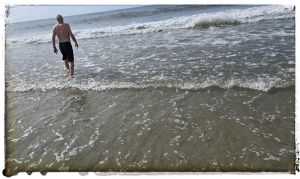
Warner Passanisi
Susie O’Neal: A Caring Life
“I like physical jobs. I gravitate to them. I was an organic gardener outside Wilmington before I returned to the island.”
We are talking today on the back dock at Ocracoke Seafood, the island fishermen’s co-op, about fifteen feet from where she spent so many days of her childhood. Susie O’Neal, the general manager of the island seafood co-op and a retail seafood market, grew up on Ocracoke during summers. She was usually in the harbor or at the beach, either way in a bathing suit all day long. Her grandmother, Mary Ruth Kelly, had one parent from Ocracoke and one from Belhaven. Mary Ruth’s father was a ship captain, and three of her four brothers were also ship captains moving freight along the East Coast. Susie loves water. “It’s like a cocoon,” she said, “safe and adventurous at the same time. . . . Water is my meditation, when I’m needing to calm myself. Water keeps me safe.”
At eighteen Susie left college and returned to the island. She lived in the fish house on Northern Pond. There she began to learn about all kinds of fish and about the harder fish to clean: sheepshead, black and red drum, and tuna. At seventeen she had begun working her way around many island restaurants. She loved walking in the early morning past the British Cemetery to get to the breakfast shift at the Island Inn Dining Room. In her thirty years in restaurants she’s worked at Captain Ben’s, Howard’s Pub, fourteen years at the Back Porch, Jason’s, and was a co-owner in opening the Flying Melon. She also worked as a FedEx driver for three years, and for ten years in the organic farming business near Wilmington. There she organized a coalition of youth workers aligning with farmers to offer organic produce from forty farms in Bladen, Brunswick, and Columbus counties. She also managed the local farmers’ market. At age fifty-seven she moved back to the island and began exploring the seafood market business.
Today she sees commercial fishing as an old and honorable profession. “Feeding people is a gift, especially food with no pesticides, a fairly pure product,” she says. In her family Susie had learned that “food was love.” Her parents taught her to appreciate variety. She learned to try different foods and to explore a variety of preparation treatments. Her dad was in the navy and diplomatic corps, and her parents wanted their children to be curious about many cultures. Susie really enjoys the variety of people all around the fishing business—sales vendors, fishermen, and the retail public. She likes to deal with people and calls them “the real asset of business!”
Today she finds herself in a lively, political, and interesting business. Some days she wears a T-shirt that says, “Commercial fishing is not a crime.” And she works daily to help visitors understand that fishing is an ever-changing and regulated business. “Lots of people are in the regulation,” she says, “but not in the catching business.” She wonders that visitors often don’t understand that fish and seafood have seasons, they are not available all the time! Catches are regulated at the state and federal levels, including by the NC Marine Fisheries, and the Department of Agriculture. The local fishermen and -women know the regulations and the counting of allowable pounds starts with them. Then counting continues inside the fish house. All commercial and recreational species are given a quota, a total amount, that may be caught of that species. On Ocracoke Island the largest crop we have is shrimp. And for fish, highest catches permitted are Spanish mackerel and bluefish. Island families have passed commercial fishing knowledge through generations. In off seasons the families work on their equipment, nets, and boats to be ready when seasons open again.
In addition to complying with fish regulations and running a sanitarian-approved public market, Susie is a great cook. She now offers catering and various homemade items for sale. Homemade drum fish cakes, crab cakes, cocktail sauce, and key lime pie are a few favorites.
Susie considers herself very lucky in her work. In a male-dominated business she is happily succeeding. She enjoys many parts of it and sees some future directions. She wants to help visitors understand that offering fresh seafood means not every species is in season year round, like it may be in their local grocery store back home. “We need to change the expectations about constant availability and help folks look forward to the fresh species they most love. In this knowledge they become more aware of the values of healthy and fresh.” Her job now includes driving a refrigerated van up the Outer Banks once a week, dropping off island oysters and clams and picking up Outer Banks’ tuna, tilefish, and more. Susie is also a caring mom. Her two sons are involved in traditional island occupations: one in charter fishing, and the other in carpentry and restaurant work.
At age sixty-two, one of her favorite moments comes in early morning when she enjoys the back deck. She hears the sounds of herring gulls cry, and this sound is timeless for her. It is her connection to island life, family, fishing, water, and boats. She is close to the dock she jumped off as a girl. She is home.
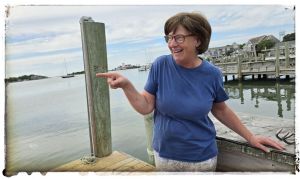
Susie O’Neal
Captain Rob Temple: A Sailing Life
“I knew I loved water early on, but I got attracted to sailing on water when I was a teenager in Charleston. My dad bought a sixteen-foot sailboat for my brother and me. My cousin, Florence Nash, today a North Carolina poet, came down to see us for a week and she wanted to go sailing, and she knew how. She said, ‘We’re going to sail out to Fort Sumter. Ask all the questions you want on the way out, and none on the way back.’ And that’s what we did.”
Captain Rob has been making a living for forty-four years with his sailboat. He bought his first boat in Annapolis in 1974 and sailed it to the Florida Keys. He had seen in those early sailing days in Charleston Harbor that whatever stresses the land held seemed to diminish as he watched the peninsula shrink to a manageable size, and that had an appeal for him. Later in the 1970s he lived on the Chesapeake Bay and then in the Keys, working on charter sailboats. At that point he thought sailing was “something to do until I figured out what else to do.”
But he discovered again and again that sailing was something he never got tired of. He like relating and meeting new people out on the water. He liked “sailing with technology that is prehistoric and working with nature.” His present boat is the basic schooner design from two hundred years ago. Built in 1980 by Ted Brewer, one of thirty-six boats built in the 1970s, she is 32 feet long. He takes charter trips of six people out of Ocracoke Harbor, weather permitting.
Rob acknowledges that he came from a family of “overachievers.” He should have been a teacher, doctor, or joined a long line of Episcopal clergy in his family. Both his father and brother went to Virginia Seminary, but he chose another path. For a while he worked with a substance abuse program on the Eastern Shore but eventually sold his house and went sailing. One day he stopped rationalizing that he needed to save the world and settled into doing what he liked best “to put food on the table.”
For twenty-five years Captain Rob spends half the year on Ocracoke Island and half in the Everglades, running sailing trips in both places. He loves talking with travelers about authors he likes, sharing tales of Blackbeard the pirate, and fielding more and more questions about climate change. In 1993 he met the woman he married on Ocracoke Island and they have a beautiful and talented family together. At age seventy-nine Rob says, “I’m still happy with my sailing life.” In closing he told me he was talking with a longtime island friend and they agreed about their contentment with their lives. “We’ve got enough!” his friend said and they both smiled and nodded together.
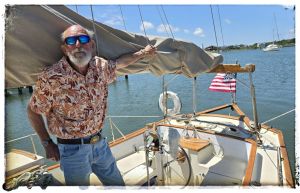
Captain Rob
Ann Ehringhaus: An Artistic and Feeling Life
“The ocean is my favorite place to be.”
It’s early morning on the island and I’m heading to the beach in my old Jeep. Time for a swim. Since passing my island bed-and-breakfast business to its new owners, I like to swim in the early light and enjoy the emptiness of the beach. Truly a primeval sight: ancient, simple, and nourishing. The ocean reminds me of the most original and creative source of life. It seems to invite my creativity to emerge, as it has for many decades. My creativity arises for the things I care about and love. First came a book, Ocracoke Portrait, in 1988, about the island community, then came Ten Thousand Breakfasts in 2013, about my thirty years in the bed-and-breakfast business. Next came several collaborations about meditation, beauty, poetry, and another, Ocracoke A.D. (After Dorian), written with Heather Johnson, in 2023, about the largest hurricane ever to come to our town. And all along the years my fine art photography has been shown throughout the Southeast.
I need to be immersed in the creative process. Time and again it has shown me that “accidents” will move my project into a direction I may not have “known” was needed. Once working with a project, random statements or images that I encounter can be important factors in the project’s outcome. Knowing when to stop is important and can’t be rushed. And learning how to accept feedback from those who view or read the project is helpful too. Living life as an artist is invigorating and helps me grow in accepting the power of the unknown.
Another guiding force in my life is feelings. I have always been a deeply intuitive person. My feelings have guided my life choices. Over thirty years ago a practitioner of Rosen Method Emotional Bodywork stayed at my B&B and I signed up for a session. This bodywork was unlike anything I had ever experienced! It honored feelings. When I was a young girl no one ever said to me, “Thank you for feeling so much and so deeply”! No one encouraged feelings or seemed interested in the knowledge they carry. No one around me ever suggested that feelings or emotions were gifts. I wondered how a little girl with big feelings could be so scary to adults when feelings made me feel so alive in my heart and body. These questions intrigued and carried me into some of my life’s work: listening more deeply to my own feelings and encouraging others to do the same.
It was my good fortune to study and assist with Marion Rosen, founder of Rosen Method, and a somatic pioneer, in Berkeley, California, along with other conscious teachers for twelve winters in the 1990s and early 2000s. By continuing to study and practice Rosen Method gentle emotional bodywork, Reiki healing, and Chinese acupressure for decades I have learned a lot about why so many feeling and sensitive people have abandoned their feelings. In a word: survival. Many painful and long-forgotten experiences of personal loss have become dormant in our bodies. Is it now time for these feelings and energies to come into Light? Can a very old story of repression or depression take a new turn? Can we begin at any age to reclaim ourselves, feel the past losses, and gradually . . . breathe more consciously into our own bodies, be more fully ourselves, . . . give up the body protection we needed earlier in our lives? Embody who we are becoming? As we live into our hearts, our breath, and even our souls, we might also expand, through this new acceptance of more of ourselves, into spiritual awareness? All of these recovered and discovered possibilities might, quite simply . . . change everything.
Today at age seventy-five, my life is still centered on the ocean and island community, art, and practicing/teaching healing bodywork on and off the island. These are the things I love. When feelings release as part of the natural flow of life, I feel the power of tears and all emotions bring us into the present moment. Then we can focus on how to share our feelings in ways that don’t harm others. This may be a new language for many, and one I personally believe we can evolve into. I am thankful the ocean shows me what different weather looks like. Living in flow with the currents of our lives and feelings is a beautiful gift of aliveness.
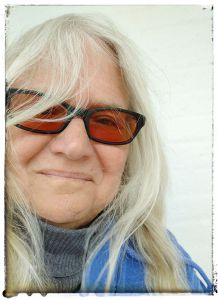
Ann Ehringhaus
Thanks to the three folks who were interviewed for this article. One interview was early morning at the ocean and we both ran into the water when it was done. The other two were on docks overlooking Silver Lake Harbor. Water was close. And my own vignette honored the power of artistic and emotional life that can happen wherever we can allow it. Many books today offer scientific thoughts about the power of water to calm and center ourselves. And of course there is nothing like direct experience! Water is the path that leads us everywhere.
*All photographs taken by the author.


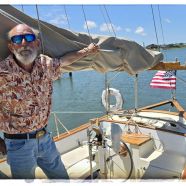





I love this, Ann. Thank you. It has been very soothing to my soul reading it this early morning.